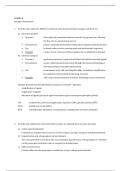Lecture 6
Synaptic transmission
1. Describe and explain the differences between electrical and chemical synapses and their use.
a) Electrical synapses
• Structure direct physical connection between neurons via gap junctions, allowing
the flow of ions and electrical current
• Transmission passive, rapid and bidirectional transmission of signals (small molecules)
• Use in simple reflex circuits, ensuring quick and synchronized responses
• Example cardiac muscle cells use electrical synapses for coordinated contraction
b) Chemical synapses
• Structure gap between neurons (synaptic cleft) where transmitters transmit signals
• Transmission slower, unidirectional transmission through the release and binding of
Neurotransmitters (tuneable transmission)
• Use predominant in the CNS, providing flexibility, modulation, amplification
for regulated activity; plasticity (learning, memory)
• Example ACh release at neuromuscular junctions, facilitating muscle contraction
Synaptic transmission through chemical synapses is tuneable > plasticity
- Amplification of signals
- Suppression of signals
- Alteration of signals (electrical signal translated to gene transcription/phosphorylation)
SVs acetylcholine, amino acids (glutamate, aspartate, GABA, glycine), purines (ATP)
DCVs peptide neurotransmitters
Both catecholamines (dopamine, norepinephrine, epinephrine), serotonin, histamine
2. Describe and explain how neurotransmitter vesicles are released upon an action potential.
a) Action potential initiation
Potentials are initiated when a neuron receives a signal, causing a change in membrane potential
b) Depolarization and voltage-gated calcium channels
The action potential travels down the axon, leading to depolarization. Voltage-gated Ca2+ channels
on the presynaptic membrane open in response to depolarization
c) Influx of calcium ions
Calcium influx into the presynaptic terminal due to open voltage-gated channels
, d) Vesicle docking and priming
Intracellular Ca2+ triggers the migration and docking of synaptic vesicles containing neurotrans-
mitters toward the presynaptic membrane. Vesicles undergo priming, a process preparing them for
fusion with the membrane
* calcium is detected by the protein synaptotagmin
Docking attachment of the vesicle to the release site
Priming vesicles are prepares for fast release; the primed vesicles are part of the
readily releasable pool RRP
Calcium sensing calcium influx triggers fusion of the synaptic vesicle membrane with the
plasma membrane, releasing the neurotransmitters into the synaptic cleft
e) Vesicle fusion and exocytosis
Fusion proteins (SNARE) facilitate the merging of the vesicle and the presynaptic membrane. The
lipid bilayers merge, leading to exocytosis of neurotransmitters into the synaptic cleft
Key proteins involved in the merging of membranes:
• Synaptotagmin on the small vesicle calcium sensor
• Synaptobrevin on the small vesicle SNARE
• Syntaxin on the plasma membrane SNARE
• SNAP-25 on the plasma membrane SNARE
There are free SNAREs on the SV and on the plasma membrane. SNARE complexes form as the SV
docks. Synaptotagmin on the SV binds to the SNARE complex. Entering Ca2+ binds to synaptotagmin
which leads to curvature of the plasma membrane. This brings the membranes together. Finally,
fusion of the membranes leads to an exocytotic release of the neurotransmitter
> synaptic vesicle fusion is coupled to calcium influx
f) Neurotransmitter binding to receptors
Released neurotransmitters bind to receptors on the postsynaptic membrane, initiating a response
in the postsynaptic neuron
g) Reuptake or degradation
Neurotransmitters can be reabsorbed into the presynaptic neuron through reuptake transporters
or enzymatically degraded in the synaptic cleft
3. Describe and explain how to discriminate between excitatory and inhibitory neurons.
, Excitatory neurons typically release neurotransmitters like glutamate. These neurotransmitters bind
to receptors on the postsynaptic membrane, leading to depolarization by allowing the influx of
positively charged ions (Na+).
Excitatory neurotransmitters open ligand-gated ion channels, allowing the flow of ions into the
postsynaptic neuron. This influx of positive ions causes depolarization and facilitates generation of an
action potential.
Inhibitory neurons release neurotransmitters like GABA. These neurotransmitters bind to receptors,
leading to hyperpolarization by allowing the influx of negatively charged ions (Cl-).
Inhibitory neurotransmitters make the postsynaptic membrane more negative, making it less likely to
generate an action potential. This inhibits the firing of the neuron and suppresses excitability.
Thus, excitatory neurons promote neural activation and signal transmission, while inhibitory neurons
dampen neural activity and control the balance of excitation and inhibition in the nervous system.





